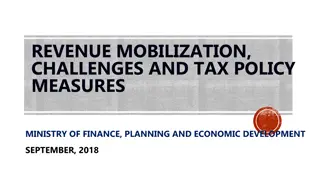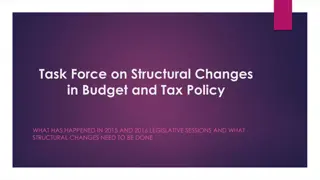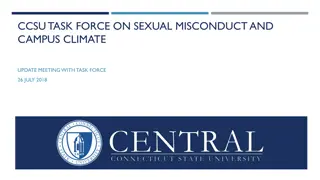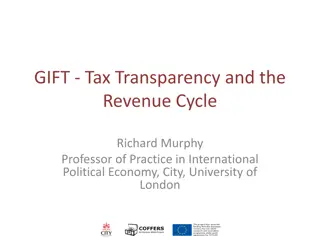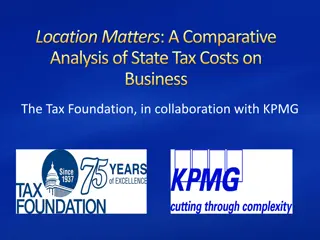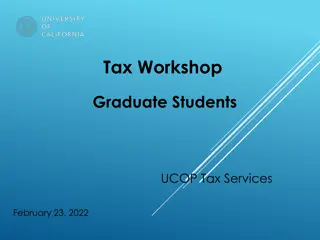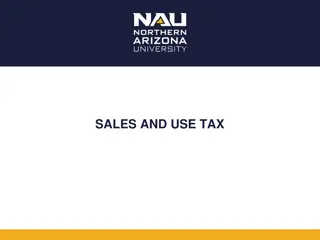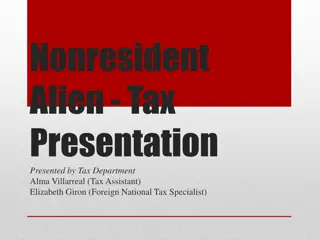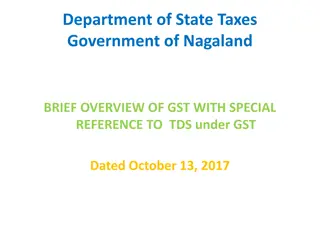Structural Changes in Budget and Tax Policy Task Force Report
The Task Force on Structural Changes in Budget and Tax Policy in Louisiana was created to address fiscal gaps and sustainability issues in funding state services. The report emphasizes the importance of examining state spending and revenue mechanisms for effective budgetary framework and tax policy.
Uploaded on Feb 17, 2025 | 0 Views
Download Presentation

Please find below an Image/Link to download the presentation.
The content on the website is provided AS IS for your information and personal use only. It may not be sold, licensed, or shared on other websites without obtaining consent from the author.If you encounter any issues during the download, it is possible that the publisher has removed the file from their server.
You are allowed to download the files provided on this website for personal or commercial use, subject to the condition that they are used lawfully. All files are the property of their respective owners.
The content on the website is provided AS IS for your information and personal use only. It may not be sold, licensed, or shared on other websites without obtaining consent from the author.
E N D
Presentation Transcript
Report of HCR 11 Task Force on Structural Changes in Budget and Tax Policy 2/17/2025 1
Role of The Task Force as created by HCR 11 In 2010 The Commission on Streamlining Government, created during the 2009 regular session of the Louisiana Legislature, issued a report with 238 recommendations to be considered, debated, and then accepted, modified, or rejected regarding the elimination, streamlining, consolidation, privatization, or outsourcing of state services with the focus on reducing the size of state government. The need for such action was summarized as follows: The state of Louisiana faces a severe decline in revenues through fiscal year 2012 which, if no corrective action is taken, will leave a significant funding gap in state government expenditures and will create serious sustainability issues in financing of state obligations. In 2016 the state of Louisiana is facing the very same fiscal gap in upcoming fiscal years between the dollars generated by its revenue structure and the dollars needed to pay for the services the state s leaders believe are in the best interest of the state s citizens. HCR 11 asked this Task Force to examine both spending by the state and how the state pays for these public services. The members of the Task Force submits its recommendations to the members of the State Legislature and the Governor of the State of Louisiana with our greatest admiration and respect for their efforts on behalf of the citizens of Louisiana. 2/17/2025 2
Establishing Budgetary Framework Fundamental Purpose of Tax System: Provide sufficient revenues to fund public services First Step: Decide how much state wants to spend on public services Second Step: Decide how to pay for these public services with the tax structure having these qualities: Short and long-term stability Fairness across and among various income groups Economic competitiveness ideally, a competitive tax environment will mean that special programs to attract business to the state can be minimized Simplicity reducing exemptions, deductions, and credits that expand the length and number of the tax forms, that add to taxpayer compliance burdens, and that create distortions in taxpayer behaviors Stability, fairness, competitiveness, and simplicity are achieved with a broad tax base and the lowest rates possible. 2/17/2025 3
Louisiana in 2017 State Budget for FY 2017 $26.3 billion According to HB 1 Digest Taxes, Licenses, and Fees $12.032 billion From Revenue Estimating Conference, 6/30/2016 State General Fund $9.624 billion Statutory Dedications, from REC Estimates $2.407 billion From Revenue Estimating Conference, 6/30/2016 Statutory Dedications, not listed in REC estimates $0.368 billion Estimated from data from REC and HB 1 Digest Fees and Self-Generated Funds $2.3 billion According to HB 1 Digest Federal Funding $11.6 billion According to HB 1 Digest Focus is on Taxes, Licenses, and Fees which includes the State General Fund and Statutory Dedications included in the REC forecasts 2/17/2025 4
Projected Budget Outlook Based on Current Expenditures and Tax Structure $14.00 $13.50 $13.00 $12.50 Billions of Dollars Approaching $2 billion shortfall in 2020 $12.00 $11.50 $11.00 Must Make Fundamental Decisions about Spending And/or taxes in 2017 so changes, either spending or tax changes, can be implemented by Fiscal 2018. $10.50 $10.00 2017 2018 2019 2020 2021 Projected Revenues $12.03 $12.32 $11.21 $11.40 $11.68 Projected Expenditures $12.032 $12.39 $12.76 $13.15 $13.54 2/17/2025 5
SPENDING CHOICES AND RECOMMENDATIONS 2/17/2025 6
Examining Public Sector Programs Is the state presently investing too little or too much in certain activities that typically are considered to be necessary public services provided by the State Elementary and Secondary Education--MFP Early Childhood development Transportation and Infrastructure Higher Education Healthcare Children and family services Workforce development Public safety Certain spending should be examined by a Task Force with special expertise on the issue. Efficiencies will not be mere budgeting exercises or reducing the number of cars being used or not filling vacant positions, but possibly fundamental changes in how a certain activity is operating. The task force should be composed of persons with expertise in the activities of the state agencies being reviewed A suggestion to make the task force s work more meaningful is to consider suggestions contained in the Roach Plan with the Task Force to be created by a resolution of the Legislature Option 1: Task Force recommendations to be considered by Legislature according to standard legislature procedures, but Task Force recommendations, as amended through the legislature procedure, must be voted on by full House and Senate Option 2: Task Force recommendations to be voted on as presented to Legislature and will go to the Governor for his signature unless 60% of the Legislature votes to reject them. This Task Force must be created by created by a 2/3rd vote of the House and Senate. Examining fundamental changes in the delivery of public services is a long-run project and the changes must be accepted across the political spectrum Transportation and Infrastructure: a task force is already reviewing- critical issues facing U.S. and every state in the union. MFP last reviewed in the late 1990s; a real need to examine the current formula and the state s contribution Update early childhood development changes an issue that is getting national attention Appropriate funding of public higher education Appropriate retirement plans for new state employees to avoid any future UAL 2/17/2025 7
Budgetary Practices and Possible Changes Dedications and non-discretionary spending allocations that may not get appropriate legislative oversight Keep constitutional dedications; transportation; and coastal restoration Eliminate all other dedications, but this will not necessarily free up resources since many of these dedications support public endeavors that citizens will want to keep Contracts Contracts represent a method of privatization it is a method of limiting size of government; indeed, it was the method by which Louisiana reduced its number of public employees substantially (arranging public/private partnerships with respect to the charity hospitals) Distribution of contracts: the top 50 make up a large percentage of overall cost of contracts Every contract should be examined, but it will not by itself necessarily produce large savings; the Commission on Streamlining Government made this recommendation in 2010 Limit on Public Expenditures Must make sure we are spending the right amount on public services at this time Rules can impose restraints on government in any emergency The constitutional amendment to limit the use of mineral revenues and corporate income taxes represents another method of reducing the state s ability to use volatile revenue sources to fund permanent projects these volatile revenue sources peak such as oil prices peaking in 2008 at the very same time that corporate tax collections climbed to over $1.1 billion. Amendment 5 on the November ballot serves as a method of limiting the ability of future legislatures to appropriate dollars for permanent operations, such as a pay increase for all state employees, based on the most volatile of revenues. These revenues will decline just as they can risen dramatically. 2/17/2025 8
Common Cost Across State Government: Unfunded Accrued Liability The state allocates UAL on a per employee basis. UAL rates range from around 21.4% for higher education to over 31% for state agencies. Initial UAL (debt incurred prior to 1989) must be paid off by 2029 according to Constitution. Debt incurred after 1989 must be paid off in 30 years. UAL payments for LSERS and TRSL amounts statewide to about $1.5 billion and will grow to about $1.7 billion per year in the mid-2020s. These payments distort the state s support for various public services, such as for higher education and the MFP the state s contribution of $3.4 billion is diminished by the UAL payment. Payments for UAL distort state support of other public services. Proposal: Gradually remove UAL as a per employee add-on Work with state agencies to work through issues of federal payments Devise self-generating payments for UAL and other technical issues This proposal has nothing to do with possible changes in the retirement systems it only deals with debts that have been accumulated in the past that are obligations of the state. 2/17/2025 9
Focus on Tax Base: means definition of what is taxable and any exemptions and deductions thereby reducing tax base Tax Rates: Keeping as Low as possible Tax liability: means determining rates to be levied and examining any tax credits which reduce tax liability TAX CHOICES: SALES, INDIVIDUAL INCOME, AND CIFT 2/17/2025 10
Estimated Taxes for Fiscal 2017 Sources of Revenues, Fiscal 2017 (thousands) Perspectives General Sales and Sales Tax on MV $4,298.1 35.7% Over 60% of Revenues. Must find most efficient and equitable way of using sales and PIT. Cannot Avoid Making Fundamental Decisions about Sales & Income taxes. Individual Income Tax $3,088.3 25.7% CIFT $510.4 4.2% Allow CI changes to be utilized. Assess Inventory Tax Credit/CF. Promote Constitutional Amendment Severance/Minerals $464.6 3.9% Use of Mineral revenues; promote Constitutional Amendment Tobacco, Beer, Liquor $381.3 3.1% Increased in extraordinary sessions; no further increases for revenue purposes Gasoline/Special Fuels $624.1 5.2% Not to balance budget, but for infrastructure as needed Gaming $906.6 7.5% Must be aware of interstate competition Excise License $858.6 7.1% Needs special analysis increased in 2nd Extra Session Others $900.1 7.5% Variety of revenue sources: no changes suggested Total $12,032.1 100.0% Based on June 30 estimates For Fiscal 2018 and based on action in fiscal 2015 and 2016 we should establish a target of $12.5 billion as the expenditures to be judged as necessary by Legislature 2/17/2025 11
Tax Restructuring--Decisions Further Increases Not in Interest of State for revenue enhancements or offsets Excise tobacco, liquor, beer---already increased (increases for health reasons can be considered, but state is now > Mississippi tax on cigarettes; equal to Arkansas ; and lower than the Texas rate by 33 cents per pack) Excise license tax---needs to be examined in separate analysis (substantial interstate/intrastate issues to be examined) Gaming might look at expansion of fantasy sports betting if it becomes constitutional according to federal government, but, otherwise, gaming taxes are consistent with market conditions and competition from other states Oil and gas tax rates on oil and natural gas have been part of tax structure since 1973 and 1990 respectively. Horizontal drilling exemption was adjusted in 2015 Legislative session. We believe it could be eliminated without long-term impact on drilling in Tuscaloosa Marine Shale; obviously, it could cause some shifting of the timing of activity. Issue on oil and gas revenues should be the appropriate use of these revenues. Must Focus on these taxes Sales Tax Tax base (exemptions and exclusions) broaden base Rates---getting it back down to 4% or lower depends on base broadening Administrative Issues, working towards common state and local tax base, collection, and auditing Individual Income Tax Down-size exemptions and deductions thereby expanding tax base and down-sizing or eliminating tax credits thereby not diminishing the tax liability; both measures permit the state to lower the tax rates that apply to ALL taxpayers Rates: select rate or rates in line with appropriate distributional impact on various income categories Single rate or Progressive rate structure CIFT Definition of Tax Base improved by actions of Extraordinary sessions (kudos to Legislature and Governor) Keep subchapter S corporation Keep net Louisiana operating loss Add-back on deductible interest and expenses, intangible expenses and costs, and management fees Market sourcing of services Changes apportionment formula for calculating CIFT. These are fundamental changes to provide stability to corporate income tax base and to reduce the necessity of judicial rulings in disputes regarding tax obligations. The focus is now on the administration of these tax changes. Constitutional choice in November very important concept lower rate and expand base Eliminate federal tax deductibility in exchange for flat rate of 6.5% compared to 8.0% at top marginal rate for taxable corporate income above $200,000 Recommends approval Tax credits with respect to CIFT Keep Subchapter S Corporation and Net Louisiana Operating Loss credits Downsize and gradually eliminate Inventory tax credit and natural gas credit Keeping credit for Offshore vessels and certain telephone companies for U.S. constitutional reasons and for maintaining fairness between public service property and commercial property Eliminate all other credits except for film credit, rehabilitation of historic structures, and school readiness child care provider credit (to be covered separately) Tax Credits Motion Picture Film Credit: Present plan to fully accommodate all credits provided prior to July 2017 back load and spread payments out so as to not create fiscal issue Eliminate motion picture tax credit as of July 2017 since all studies, including studies on the Louisiana motion picture tax credit, have indicated a negative rate of return that is, the credit costs the state more than it can recover in state tax collections, either direct or indirect. Will examine any new proposal as developed by LED as it attempts to improve ROI of this tax credit Rehabilitation of Historic Structures Allow to continue per current law and undergo extensive analysis as of December 2021. School Readiness Credit 2/17/2025 12
Distribution of Current Income and Sales Tax Structure 45% 40% 35% 30% 25.9% 25.6% 25.5% 25% 20% 14.4% 15% 28.1% 27.7% 26.5% 10% 8.7% 11.4% 5% 6.3% 0% <$25,000 >$25,000, <$50,000 >$50,000, <$100,000 >$100,000, <$200,000 >$200,000 %PIT %Sales %PIT&Sales %FAGI %Taxpayers 2/17/2025 13 Legislative Fiscal Office
Estimates of Sales Tax Impact on Households 30% Lowest 20%, <$19,000 Second 20%, $19,000 to $36,000 Middle 20%, $36,000 to $56,000 Fourth 20%, $56,000 to $99,000 Next 15%, $99,000 to $204,000 Next 4%, $204,000 to $507,000 Top 1%, >$507,000 25% 20% 15% 10% 5% 0% Lowest 20% Second 20% Middle 20% Fourth 20% Next 15% Next 4% Top 1% Sales tax as percentage of average income % of Sales Tax Paid by Income Group % of Income Earned by Income Group 2/17/2025 14 Institute on Taxation and Economic Policy
Goals of Tax Changes Stability: A more predictable long-term revenue stream Fairness: Improvement in progressivity of overall sales and income tax structure Competitiveness: Keep Louisiana competitive with its neighbors Simplification of tax administration: A shorter and less complicated form for taxpayers and increased voluntary compliance 2/17/2025 15
Sales Tax Options Sales Tax Base and Rate $ per 1 cent sales tax Sales Tax Base, Pre-2016 (not including Motor Vehicles) $700 million $105 million $90 million $55 million $222 million $18 million $65 million Sales Tax Base for Motor Vehicles, Sales Tax Base, ACT 26, First Extraordinary Session, Louisiana Legislature, 2016 Services, Not taxed in Louisiana but now taxed in Tennessee and Texas Food for home consumption, prescription drugs, and residential utilities Manufacturing Machinery equipment Sale of Electric Power or Energy: Non- residential 2/17/2025 16
Sales Tax Options Estimated Sales Tax Rates Under Various Tax Bases without possible feedback due to higher sales tax rates Plus Services Taxed in TX and TN but not in LA Plus Constitutional Exemptions, except gasoline Plus Non- residential energy and electricity How Much do we want to get from the sales tax? Pre-2016 Sales Tax Base, including motor vehicles Plus Act 26, 2016 Plus MME $3.2 billion 4.00 3.60 3.39 2.74 2.70 2.52 $3.5 billion 4.38 3.93 3.70 2.99 2.95 2.76 $3.75 billion 4.69 4.21 3.97 3.21 3.16 2.95 $4.0 billion 5.00 4.49 4.23 3.42 3.37 3.15 $4.5 billion 5.63 5.06 4.76 3.85 3.79 3.54 In fiscal 2015 the state collected $3.1 billion in general and motor vehicles sales taxes at 4%, making up approximately 30% of the state s total taxes, licenses, and fees. In 2017 the state is projected to collect $4.3 billion in general and motor vehicles sales taxes at a rate of 5% on most items, 1% on newly added items to the tax base, and other various rates. 2/17/2025 17
Comparing Sales Tax Base with and without Food, etc. at 5% and 3% 8.00% 7.00% 6.00% 5.00% 4.00% 3.00% 2.00% 1.00% 0.00% Lowest 20% Second 20% Middle 20% Fourth 20% Next 15% Next 4% Top 1% 5% rate, food is exempt 5% rate, food is taxable 3% rate, food is taxable 2/17/2025 18
Decision: How Much From Sales; what base; and what rate Options Pre-2016 Base, including MVs Food, utilities, and prescriptions Act 26 Services, taxed in TX and TN MME Non- residential utilities 5.0% 1% and others Present Tax Rates Pre-2016 Base Expand as in 2016 Suggest this is the most narrow base we should recommend Add Services Should add at least TX and TN services, but work into tax base Constitutional and political decision: adds stability and with rate reduction can lower burden on low income Add Food, etc. Impact on competitive- ness Add MME Add Non-res utilities 2/17/2025 19
Individual Income Tax Louisiana Taxable Income Starting Point Federal Adjusted Gross Income (millions $s) Standard Deduction/Personal Exemptions $253.9 These exemptions or deductions add up to $1.86 billion of reduced tax collections or 60% of total collections from the Individual Income Tax which means the rates have to be much higher than what they would be if these did not exist. Dependents $31.8 Retirement Exclusion LSERS/TRSL/Others Social Security Federal Retirement $253.0 REDUCE Federal AGI Military Pay for Active Duty $6.2 Disability Pay $5.8 Net Capital Appreciation $53.9 AGI in 2013 was $110 billion. Taxed is $67 billion; AGI that is exempted from tax is about $43 billion School Tuition $22.6 Others $6.3 $877.2 Federal Tax Liability $349.0 Excess Itemized Deductions Equals Louisiana Taxable Income
Rates Applied to Louisiana Taxable Income Joint Filer Single Filer Louisiana Taxable Income Rate Louisiana Taxable Income Rate $0 to $12,500 2% $0 to $25,000 2% $12,501 to $50,000 4% $25,001 to $100,000 4% > $50,000 6% > $100,000 6% Actual Tax Liability will be a based on the Louisiana Taxable Income, the rates that apply, and then any tax credits that reduce the tax liability Actual Tax Liability will be a based on the Louisiana Taxable Income, the rates that apply, and then any tax credits that reduce the tax liability
INFORMATION ABOUT LOUISIANAS INDIVIDUAL INCOME TAX
LA Taxpayers by Filing Status From IRS, 2013 120% 58,850 403,330 202,030 872,130 467,980 100% 80% 60% 40% 20% 0% Under $25,000 >$25,000, <$50,000 >$50,000,<$100,000 >$100,000, <$200,000 >$200,000 % Single Returns % Joint Returns % Head of Household
% of Taxpayers and AGI by Income Groups >$200,000 >$100,000, <$200,000 >$50,000,<$100,000 AGI = $110 Billion >$25,000, <$50,000 Under $25,000 0% 5% 10% 15% 20% 25% 30% 35% 40% 45% 50% % of Taxpayers % of AGI
Tax Exemptions, Deductions, and Credits
Tax Exemptions, Deductions, Credits (in million of dollars, estimated FY 2017) Exemptions, Not Included in or subtracted from Taxable Income expenditure or type of income Deductions from Taxable Income, Tax Credits ($278.4 or 13.2%) behavior/fair tax system Two Largest Exemptions ($1,226.3 or 57.3% of Total) Deductions rewarding or influencing behavior ($82.6 or 3.9%) Net Income Taxes Paid to other States $60.3 Net Capital Gains $53.9 Child Care-based on federal credit FITD $877.2 $18.3 School Tuition $22.6 EID $349.0 EITC $48.9 Fees, Quality Public Education $3.0 Retirement Exemptions ($253.0 or 12.1% of Total) Education ($25) $10.5 START Deduction $2.3 School Readiness $6,000 Exclusion $24.4 $14.6 Recreation Volunteer $0.02 LSERS/TRSL/ Others $93.8 Others $6.2 Volunteer Firefighter $0.06 Federal $32.0 Being altered permanently or temporarily I.R.C. Section 280C Expense $0.52 Inventory/NG/offs hore/phone SS Benefits $102.7 $33.2 Home Schooling $0.24 SD/PE ($285.7 or 13.6% of Total) Historic Credit 2021 $37.2 Military Pay $6.2 SD/PE $253.9 Citizens Property $29.2 disability $5.8 Dependents $31.8 Solar $20.0
EXEMPTIONS WE HAVE TO FACE UP TO 1. 2. 3. 4. Federal Tax Liability Excess itemized deductions These two make up almost 60% of all exemptions and credits If we add standard deduction and personal exemptions, we have close to 70% of all exemptions and credits
Individual Income Tax Increase Relative to Average Federal Adjusted Gross Income Due to Eliminating Federal Tax Liability 2.50% Raises $748.6 million based on 2014 Tax Returns 2.00% 1.50% 1.00% 0.50% 0.00%
Eliminating FID <$25,000 >$25,000, BUT <$50,000 >$50,000, BUT <$100,000 >$100,000, BUT <$200,000 >$200,000 % Taxpayers %AGI %Current Tax %Proposed Tax
TAX INCREASE DUE TO ELIMINATING FEDERAL TAX LIABILITY, UP TO $140,000 $908 $586 $439 $378 $321 $267 $177 $111 $64 $35 $20 $10 $3 $1 $0 $0 TO $5000 $5000 TO $10000 $10000 TO $15000 $15000 TO $20000 $20000 TO $25000 $25000 TO $30000 $30000 TO $40000 $40000 TO $50000 $50000 TO $60000 $60000 TO $70000 $70000 TO $80000 $80000 TO $90000 $90000 TO $100000 $100000 TO $120000 $120000 TO $140000
TAX INCREASE DUE TO ELIMINATING FEDERAL TAX LIABILITY, FROM $140,000 AND HIGHER $50,251 $16,515 $14,490 $12,465 $10,452 $8,329 $6,978 $5,987 $5,037 $4,078 $3,125 $2,295 $1,814 $1,529 $1,257 $140000 TO $160000 $160000 TO $180000 $180000 TO $200000 $200000 TO $250000 $250000 TO $300000 $300000 TO $350000 $350000 TO $400000 $400000 TO $450000 $450000 TO $500000 $500000 TO $600000 $600000 TO $700000 $700000 TO $800000 $800000 TO $900000 $900000 TO $1000000 OVER $1000000
Who Pays Individual Income Tax in Louisiana with and without Federal Income Tax Deduction % Taxpayers % Federal Adjusted Gross Income % Current LA Individual Income Taxes Paid % LA Individual Income Taxes Paid without FID 45.0% Eliminating Federal Tax Deduction for Individuals Raises Approximately $750 million 40.0% 35.0% 30.0% 25.0% 20.0% 15.0% 10.0% 5.0% 0.0% less than $25,000 >$25,000, but <$50,000 >$50,000, but <$100,000 >$100,000, but <$200,000 >$200,000
Current and Estimated Without FITD ($0 to $25,000) Current Estimated without FITD $400 $350 $300 $250 $200 $150 $100 $50 $0 $0 to $5000 $5000 to $10000 $10000 to $15000 $15000 to $20000 $20000 to $25000
Current and Estimated Without FITD ($25,000 to $100,000) Current Estimated without FITD $3,000 $2,500 $2,000 $1,500 $1,000 $500 $0
Current and Estimated Without FITD ($100,000 to $200,000) Current Estimated without FITD $8,000 $7,000 $6,000 $5,000 $4,000 $3,000 $2,000 $1,000 $0 $100000 to $120000 $120000 to $140000 $140000 to $160000 $160000 to $180000 $180000 to $200000
Current and Estimated Without FITD ($200,000 and Above) Current Estimated without FITD $160,000 $140,000 $120,000 $100,000 $80,000 $60,000 $40,000 $20,000 $0 $200000 to $250000 $250000 to $300000 $300000 to $350000 $350000 to $400000 $400000 to $450000 $450000 to $500000 $500000 to $600000 $600000 to $700000 $700000 to $800000 $800000 to $900000 $900000 to $1000000 over $1000000
Number of Taxpayers Who File Schedule A on Federal Tax Returns (420,252 in total or about 25%) Income Range # of Taxpayers Itemizing Income Range # of Taxpayers Itemizing Income Range # of Taxpayers Itemizing $0 to $5000 1,882 $70000 to $80000 27,020 $300000 to $350000 6,087 $5000 to $10000 3,223 $80000 to $90000 24,485 $350000 to $400000 3,999 $10000 to $15000 5,863 $90000 to $100000 22,773 $400000 to $450000 2,830 $15000 to $20000 8,322 $100000 to $120000 40,003 $450000 to $500000 2,115 $20000 to $25000 10,418 $120000 to $140000 30,951 $500000 to $600000 2,725 $25000 to $30000 12,747 $140000 to $160000 23,090 $600000 to $700000 1,644 $30000 to $40000 30,732 $160000 to $180000 16,906 $700000 to $800000 1,144 $40000 to $50000 34,246 $180000 to $200000 12,012 $800000 to $900000 785 $900000 to $1000000 $50000 to $60000 32,922 $200000 to $250000 18,092 555 $60000 to $70000 29,773 $250000 to $300000 10,070 over $1000000 2,838
Number of LA Taxpayers Filing Schedule A with Federal Tax Returns 160,000 About 25% of LA Taxpayers 140,000 120,000 100,000 80,000 60,000 40,000 20,000 0 <$25,000 >$25,000, but <$50,000 >$50,000, but <$100,000 >$100,000, but <$200,000 >$200,000
Estimated Itemized Deductions, 2014 $200,000 $180,000 $160,000 $140,000 $120,000 $100,000 $80,000 $60,000 $40,000 $20,000 $0
Tax Increase Due to Eliminating Federal Tax Liability, from $0 to $100,000 $600 $500 $400 $300 $200 $100 $0 $0 to $5000 $5000 to $10000 $10000 to $15000 $15000 to $20000 $20000 to $25000 $25000 to $30000 $30000 to $40000 $40000 to $50000 $50000 to $60000 $60000 to $70000 $70000 to $80000 $80000 to $90000 $90000 to $100000
Tax Increase Due to Eliminating Federal Tax Liability, $100,000 and up $12,000 $10,000 $8,000 $6,000 $4,000 $2,000 $0 $100000 to $120000 $120000 to $140000 $140000 to $160000 $160000 to $180000 $180000 to $200000 $200000 to $250000 $250000 to $300000 $300000 to $350000 $350000 to $400000 $400000 to $450000 $450000 to $500000 $500000 to $600000 $600000 to $700000 $700000 to $800000 $800000 to $900000 $900000 to $1000000 over $1000000
Individual Income Tax Increase Relative to Average Federal Adjusted Gross Income Due to Eliminating Excess Itemized Deductions for taxpayers itemizing at the federal level 1.2% 1.0% 420,252 Louisiana taxpayers who Itemize at Federal Level 0.8% Raises approximately $350 million 0.6% 0.4% 0.2% 0.0%
Suggestions for Exemptions and Credits Ask People to Eliminate Federal Tax Liability in exchange for lower rates Excess Itemized Deductions: Allow up to $7,500 per tax return Average retirement for Persons in Teachers and State Workers is around $25,000. Allow retirement exemptions to be limited to first $30,000 of a person s retirement. This will also be somewhat comparable to how the Federal government handles Social Security Make following suggestions for other credits Eliminate education credits Allow historic tax credit to be reviewed in 2021 film credit for existing credits to be redeemed over time; eliminate motion picture credit as of July 2017; review changes as suggested by LED Keep earned income tax credit and child care credits and, if add food, etc. to sales tax base, increase from 3.5% to 10% Establish inventory tax credit and natural gas tax credit at 50% of inventory ad valorem liability and gradually eliminate over a 5 year period
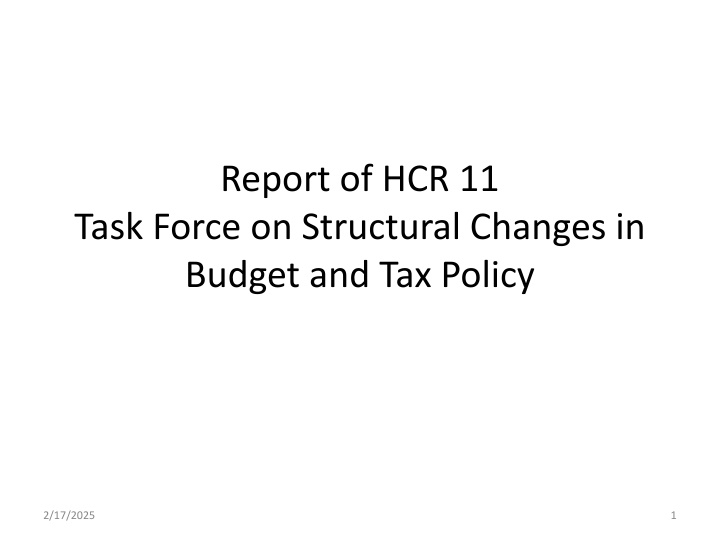

![Town of [Town Name] Real Estate Tax Rates and FY 2024 Budget Summary](/thumb/62211/town-of-town-name-real-estate-tax-rates-and-fy-2024-budget-summary.jpg)




